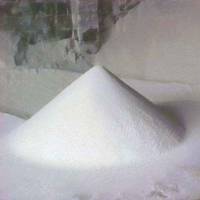 Urea is a white crystalline substance with the chemical formula CO(NH2)2; it is highly water soluble and contains 46% nitrogen. Urea is considered an organic compound because it contains carbon. It was the first organic compound ever synthesized by chemists; this was accomplished in the early 1800s. Urea is a white crystalline substance with the chemical formula CO(NH2)2; it is highly water soluble and contains 46% nitrogen. Urea is considered an organic compound because it contains carbon. It was the first organic compound ever synthesized by chemists; this was accomplished in the early 1800s.
HOW IS UREA MADE?
Urea is made by reacting carbon dioxide (CO2) with anhydrous ammonia (NH3) under 3,000 psi pressure and at 350° F.
CO2 + 2NH3 > CO(NH2)2 + H2O
The removal of water that occurs during the reaction is referred to as dehydration." The resulting molten mixture is further processed into either prills or granules.
 WHAT IS THE DIFFERENCE BETWEEN GRANULAR UREA AND PRILLED UREA IN TERM OF PHYSICAL APPEARANCE AND APPLICATION? WHAT IS THE DIFFERENCE BETWEEN GRANULAR UREA AND PRILLED UREA IN TERM OF PHYSICAL APPEARANCE AND APPLICATION?
Granular urea is somewhat larger in size than are prills, but the color will be the same as is the application technique.
Is it related to how the spreader machines/ applicators use bigger granulation, and hand/manually spread use prill /smaller granulation?
IS UREA USE INCREASING?
Urea use is up substantially. In the western U.S. , for example, urea use has increased from 28,000 tons in 1955 to 390,000 in 1989, a 15-fold increase. Urea is the fastest growing dry nitrogen fertilizer used by farmers.
 WHAT ROLE DOES UREA PLAY IN WORLD COMMERCE? WHAT ROLE DOES UREA PLAY IN WORLD COMMERCE?
Urea is the major fertilizer traded in international commerce. In the very near future urea is expected to account for more than 50% of the nitrogen fertilizer in world trade. When compared to other dry fertilizers, urea has captured more than 65% of the world trade.
WHY IS THERE SUCH A SHIFT TO UREA IN WORLD TRADE?
Urea has a number of advantages over other nitrogen fertilizers. Urea is safer to ship and handle, it is less corrosive to equipment, it has a higher analysis than any other dry nitrogen fertilizer and it can be used on virtually all crops. Urea can be stored and distributed through conventional systems. It can be applied in many different ways from sophisticated aerial application equipment to a farm spreading urea by hand. Urea is also highly water soluble so it moves readily into the soil. The high analysis means a reduced transportation and application cost per pound of nitrogen.
HOW MUCH NITROGEN DOES UREA CONTAIN?
Urea is 46% nitrogen. This is the highest concentration dry nitrogen fertilizer available.
HOW MUCH NITROGEN DOES UREA SUPPLY?
Urea supplies more nitrogen per ton of product than any other dry fertilizer. It contains 46% nitrogen; this means that each ton of urea supplies 920 lbs. of nitrogen. For comparison, a ton of ammonium sulfate supplies only 420 lbs. of nitrogen and a ton of ammonium nitrate supplies only 670 lbs. of nitrogen. The higher nitrogen content means lower transportation and application costs per pound of nitrogen.
 DOES UREA "TIE-UP" IN THE SOIL? DOES UREA "TIE-UP" IN THE SOIL?
Urea itself is very mobile because it is a neutral molecule; it has no charge and is not attracted to soil particles. This means it can rapidly move into the soil following irrigation or rain. Once in the soil, however, it is rapidly converted into ammonic nitrogen, which is attracted to the soil particles, thus preventing leaching loss.
WHAT IS BIURET?
Biuret is formed during the manufacturing of urea. It is two urea molecules joined together accompanied by the removal of an ammonia molecule. Biuret is of little concern for soil-applied nitrogen fertilizers, but it can be toxic when nitrogen fertilizers containing biuret are foliar-applied to sensitive crops such as citrus or pineapple.
WHAT IS THE BEST NITROGEN FERTILIZER FOR AERIAL APPLICATIONS?
Urea is the best source of nitrogen for aerial application. Because urea has the highest analysis (46% nitrogen), it has the lowest application cost per pound of nitrogen. The uniform area granules mean that applications can be accurately calibrated and evenly spread. Urea can be practically dust-free and, under most conditions, it does not absorb moisture and cake up.
HOW DOES UREA COMPARE WITH AMMONIUM SULFATE?
Urea has over twice as much nitrogen as does ammonium sulfate; 46% versus 21%. That means there is more than twice as much nitrogen as per ton of fertilizer. In addition, urea is less acid forming, is more water soluble and less corrosive. Ammonium sulfate does supply sulfur, but it is usually less expensive to apply urea and a sulfur material such as elemental sulfur.
HOW DOES UREA COMPARE WITH AMMONIUM NITRATE?
Urea contains about one-third more nitrogen, is less corrosive than ammonium nitrate and is less prone to caking. In addition, all the nitrogen is in the ammonic form and, until nitrification occurs, it is less subject to leaching or de-nitrification than the nitrate portion of the ammonium nitrate.
IS THE NITROGEN IN UREA DIFFERENT FROM NITROGEN IN "ORGANIC FERTILIZERS" IN TERMS OF PLANT NUTRITION?
No; the ammonic nitrogen or nitrate nitrogen taken up by plants is chemically identical regardless of the source. Nitrate or ammonium that results from urea application is indistinguishable from the nitrate or ammonium that results from manure application. A plant utilizes inorganic ions, and the source of these nutrients is irrelevant to either the yield or quality of the fruit, grain, or vegetative matter produced by the plant.
Click here to fill out the Online Request Form |